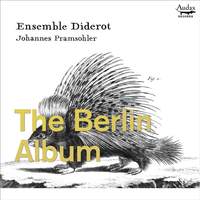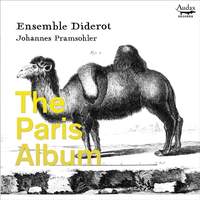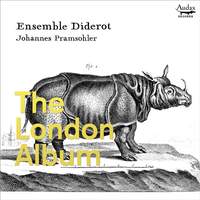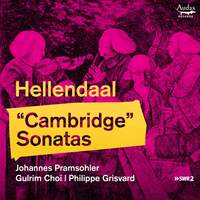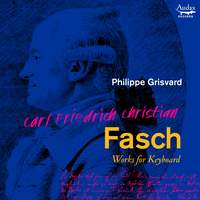Interview,
Johannes Pramsohler on Baroque music in Berlin
 I've become an avid follower of Ensemble Diderot's series of albums, which focus on trio-sonata traditions in various cities around Europe. The group never fail to impress with their combination of meticulous research and lively performance.
I've become an avid follower of Ensemble Diderot's series of albums, which focus on trio-sonata traditions in various cities around Europe. The group never fail to impress with their combination of meticulous research and lively performance.
Although violinist and director Johannes Pramsohler stresses that building a programme around a series of geographical "gimmicks" is never the group's vision for these albums, the shifts in musical fashions and prominence over time mean that they naturally fall into focusing on one city after another as they trace the evolution of their specialist genre.
The latest stop is Berlin – where, under the auspices of culturally ambitious rulers, some profound changes in the social function of music itself took root. I spoke to Johannes to find out more.
Before the famously musical Prussian monarch Frederick II transformed the cultural life of his capital Berlin, the city seems to have been quite musically unremarkable, and particularly envious of Dresden’s flourishing scene. Why do you think Berlin lagged behind other European cities for so long?
I think at that time it was very dependent on what the local rulers did or didn’t do. It’s not so much to do with the cities themselves but to do with who was in charge of them. In Dresden they were very interested in anything relating to art – not just music but everything, even things like ceramics. That’s why it became such an important centre.
If you think of Paris, starting with Louis XIV that was a similar situation – he used that cultural life as a sign of his power. In France it became quite a uniform landscape, because of things like Lully’s monopoly – it’s always shaped by these kinds of people. The interesting thing with Berlin is that we also see the opening up of culture to the public – concerts where everyone could attend. It marks a shift from court music and it starts to be more connected to the people in general.
Johann Janitsch took Berlin music-making out of the royal court and into the public sphere with a regular series of Friday concerts. How significant a shakeup was this in terms of changing the potential audience and market for music in the city – did it affect what music was subsequently written and performed?
Yes – it takes the form of the music becoming easier. The bass movement and harmonic movement slowed down, so the music could accommodate an easier melody line, which allowed amateurs to play it. This remains true right through to the Classical period, with Haydn’s string quartets for example; people could play them at home fairly readily. Similarly Beethoven’s Op.18 – it’s all made for people to play at home. It’s easier and more accessible.
I’m working on a project at the moment that focuses on opera around Mozart, and what you find is that Mozart was in some ways the least popular composer, compared to others like Sarti and Paisiello who were writing in Italy – because they wrote easier music! Mozart was too complicated and too dense – the Bach of his time. So this phenomenon certainly wasn’t limited to Berlin, but I think that’s where it began.
However, the sonatas we chose for the Berlin album are extremely difficult and were surely all written for professional virtuosos. In the Janitsch sonata both violins constantly play in 7th position, one of the Graun sonatas is written for scordatura violin and the Kirnberger sonata is rhythmically so tricky that no amateur player would have been able to play it.
The treasures of the recently-rediscovered archives of the Berliner Singakademie are represented here by one of numerous fugues composed by the princess Anna Amalia. Would it have been common for fugues to be performed as “secular” concert pieces at this time, or were they reserved mostly for use in church and as counterpoint exercises?
I’m not sure that they were concert pieces as such. We know of four fugues by Anna Amalia and they seem like composition exercises; her teacher, Kirnberger, was very keen on that kind of thing, and he did exercises with her which are where I think these fugues come from. To be able to write a fugue was considered the highest achievement for a composer at that time (as in some ways it still is today).
Regarding church services: At this time, particularly in Dresden, they had a fashion for performing sonata movements, say from one of the Corelli-style “church” sonatas where there’s an adagio followed by a fugue. They used to play the first two movements – the slow movement and the fugue – during the service, at the point in the Mass called the Gradual. This would have used a full orchestra, not just the organ – we have pieces like this by Pisendel, and there’s also a trio sonata by Handel that Pisendel arranged for orchestra for this purpose. Even solo concertos might be used, but “cut in half” so to speak in order to use them in this church context – and since Berlin was always a bit behind Dresden I think they tried to imitate this practice themselves.
The instrumentation you’ve used on this recording captures the moment at which the harpsichord was first challenged by the new fortepiano. Although the two instruments coexisted for some time before the former was finally abandoned, how likely is it that both would have been used for different works in a single performance (or even simultaneously)?
I’m not sure. For us, it was very much an experiment that we did for the recording. It turned out to be quite difficult to hear the fortepiano – the moment you add the violin it’s a problem. The harpsichord at least has an edge to its tone but the fortepiano doesn’t. Our continuo player Philippe Grisvard is totally convinced by this, but personally I’m not persuaded that this was actually what they did in practice.
Pragmatically, they’d have used whatever was available in a given setting – and if that was a fortepiano, of course that’s what they’d use. It’s very difficult to comprehensively reconstruct the full approach to performance – because it would have varied depending on the instruments available. I do think, though, that the instrument to use with the violin is the harpsichord – it’s just louder than the fortepiano.
That being said, Baroque players often forget that with the harpsichord, there’s only so much piano the violin can do before the harpsichord drowns it. The fortepiano doesn’t have that limitation. Particularly in the latest piece chronologically, the Schulz trio sonata, there are many pianissimos, which you simply can’t play on the harpsichord because it’s too loud; the fortepiano allowed us to do that. It was a very interesting process and I think on the album it works brilliantly.
You allude to Berlin’s brief bid for musical prominence being eclipsed by Vienna almost as soon as it managed to emerge from Dresden’s shadow; should we anticipate a Vienna Album in the future, or has your tour of European cultural capitals come to an end?
There’s plenty more scope; I think we’d run out of capitals before we ran out of animals for the front covers! I would really like to do a Vienna Album at some point – it’s within the bounds of what we’d do, because you have people like Wagenseil who can still be considered very late Baroque. If you’d asked me this before I did this Berlin album, I would have been thinking more of Fux or Caldara, who were right at the end of the 17th century and the beginning of the 18th. But now I would like to look at the slightly later time when Vienna was taking over the limelight from Berlin.
Interestingly, we never take the city itself as the starting-point; the albums just coalesce that way during the process of putting them together. But yes, Vienna is one of the more likely options for the future. We also want to go back earlier as well – as a group we really want to understand where all this music came from, so we have concert projects (not yet recording projects) looking at the first trio sonatas by composers like Gabrieli and Rossi – the early 17th century, about 50 years before the music featured on our London and Paris albums.
In general this is how things work out; we assemble a concert programme first and then the album comes out of it later. It’s always because we want to understand a certain composer or a certain time better. The Berlin Album is actually part of a larger project; I’m currently playing Bach’s sonatas with obbligato harpsichord with Philippe, and we want to somehow embed them in the context of other sonatas and composers around Bach. Philippe also did a solo album of music by Carl Fasch – the other harpsichordist at the Prussian court, besides CPE Bach – and we’re also doing cello concertos with our cellist Gulrim Choi, which again are all from Berlin.
So it’s all part of a bigger plan where we really want to understand Berlin in a new way. There are a lot of preconceptions about this sort of thing; you go to music college and they’ll tell you “music from Berlin has to be played in this way”, and they give you a little toolkit of rules to use. We want to think outside that and understand it in our own way; that’s how the Berlin album came about.
Each of the cities that you've focused on had its own approach to performance practice; how much did you have to go 'back to the drawing board' with the research aspect of this album, to capture the things that were unique to Berlin?
Well, one thing that I didn’t mention in the notes but I’d like to talk about relates to the ornaments we use. Part of this new take on Berlin that I alluded to above is a new approach to ornamentation. There are regional schools of ornamentation – or at least that’s what your teachers will tell you! – but this is something I looked into in more detail for my doctorate at the Royal Academy in London, and it fed into the Paris and London albums. We have this way of looking at things that leads us to say, for instance, that Purcell must be done in a particularly “English” style and we place it in a box.
It reminds me of medieval reenactment fairs in German towns – everyone’s dressing up as knights and there’s organic vegetables on sale and so on, and everyone feels so sure that they’ve captured how that period truly was. But we don’t know how it was at all! And it’s the same with Baroque music; we think we know, so for instance we say “Purcell = English = melancholic”. We thought we knew in the ‘70s too, and we were wrong then. So it’s a question of broadening the options for interpretation.
Considering Purcell, we know that he wanted his trio sonatas to imitate Italian music. So why not look into how Italians were playing at that time and incorporate that? The result is maybe not a strict reconstruction of how it would have sounded in England, but maybe it’s a reconstruction of how Purcell imagined it in his head. We know that at the time the violin was very poorly regarded in England – it was considered merely an instrument for the pub – whereas in Italy it was already considered a real artistic vehicle, so maybe Purcell was imagining his music being played by an Italian virtuoso rather than an English beer-fiddler.
For the Berlin Album we even revisited some fairly basic assumptions. You always learn that appoggiaturas are on the beat and they’re long – they must be 2/3 of the note’s length, and so on. But we wanted to consider it from the perspective of how the composer wrote the piece; are there real appoggiaturas in the writing that we need to bring out, or are they notated as grace notes that we need to interpret? We did a lot of research. And with Gulrim playing concertos from Berlin and Philippe playing Carl Fasch, there were a lot of different research elements to go into the mix.
We also looked at written-out cadenzas. Depending on the player or the composer these might not be improvised, as we often assume; someone like Bach would never let the performer have that freedom to play whatever they want, so he wrote everything out including the ornaments. With violinist-composers like Tartini, for example, and his student Hellendaal, whose Cambridge sonatas I recorded quite recently, there are pages and pages of written-out cadenzas; Pisendel did the same, writing everything out. I think they would have written something out if they wanted to do something really specific, or particularly clever, that they wanted to remember and keep for next time. On this recording there are three cadenzas, one for the harpsichord and two for the violin; of the violin cadenzas one is quite elaborate, and this one is written out, and the other I improvise.
Ensemble Diderot, Johannes Pramsohler
Available Formats: CD, MP3, FLAC, Hi-Res FLAC
Ensemble Diderot, Johannes Pramsohler
Available Formats: CD, MP3, FLAC, Hi-Res FLAC
Ensemble Diderot, Johannes Pramsohler
Available Formats: CD, MP3, FLAC, Hi-Res FLAC
Ensemble Diderot, Johannes Pramsohler
Available Formats: CD, MP3, FLAC, Hi-Res FLAC
Gulrim Choi (cello), Philippe Grisvard (harpsichord), Johannes Pramsohler (violin)
Available Formats: CD, MP3, FLAC, Hi-Res FLAC
Philippe Grisvard (harpsichord)
Available Formats: CD, MP3, FLAC, Hi-Res FLAC


